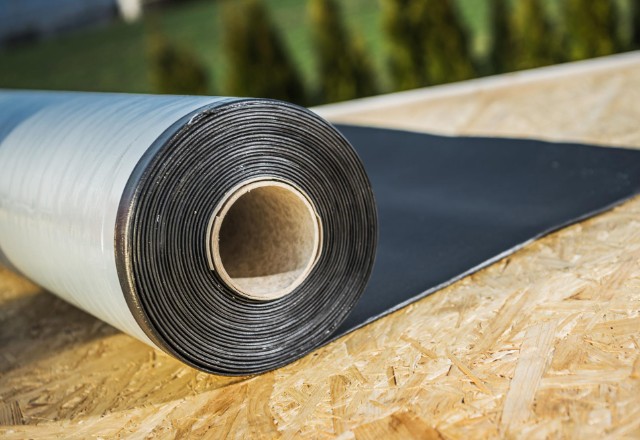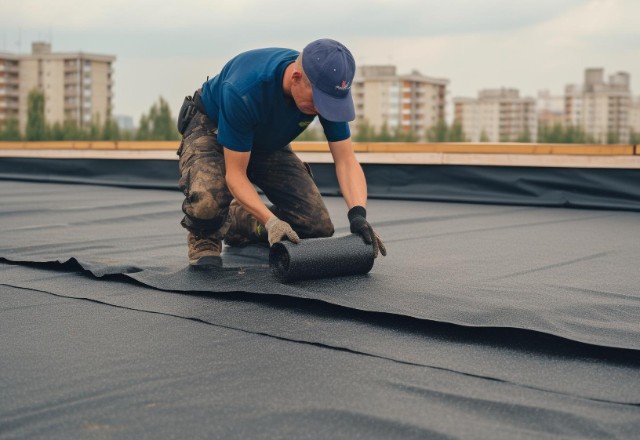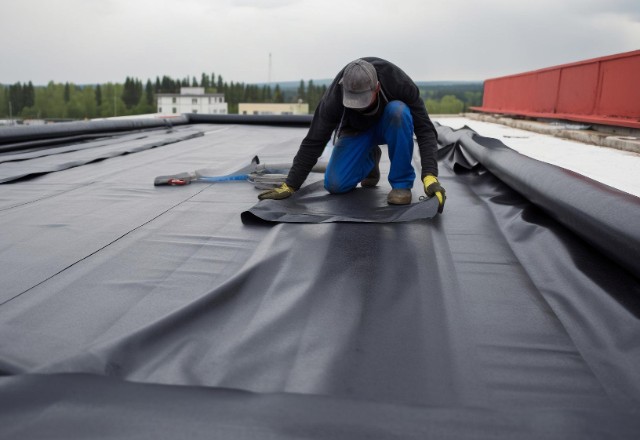TPO is an acronym that stands for Thermoplastic Olefin, which refers to a type of roofing material commonly used in commercial and residential buildings. TPO membrane roofs are single-ply roofing membranes made from a blend of polypropylene and ethylene-propylene rubber. This combination gives TPO roofs a unique set of properties, including high durability, strong puncture resistance, and resistance to chemical exposure. These features make TPO roofs a popular choice for building owners looking for a reliable and cost-effective roofing solution that offers both protection and energy savings.
Disclaimer: The information contained in this article is for general informational purposes only. While every effort has been made to ensure its accuracy, the contents of this article should not be taken as professional advice. For specific advice and guidance about roofing material choices and installation methods, we recommend consulting a qualified roofing specialist such as Advance Roofing LLC. With many years of experience in providing quality roofing services in the Spokane, WA area, our team is always ready to assist you.
Strong Sides of TPO Roofing
TPO roofing offers several advantages that make it a popular choice for both residential and commercial buildings. Let’s take a closer look at them.
Durability & Longevity
- TPO is an extremely durable roofing system designed to withstand the elements and provide long-lasting protection for commercial and residential buildings. This single-ply roofing membrane offers exceptional resistance to tears, punctures, and blistering, making it one of the most durable roofing materials on the market.
- Compared to other single-ply membranes, TPO roofing has a long shelf life and can withstand the harshest weather conditions, including high winds, heavy rain, and intense heat. Its heat-weldable nature allows for easy repairs by an experienced roofing contractor, ensuring that any minor damages can be quickly and efficiently fixed.
- For increased strength and longevity, it is recommended to install a thicker TPO membrane. This thicker membrane provides an extra layer of protection and helps to prevent any potential issues that may arise from foot traffic, equipment installation, or chemical exposure.
Cost-Efficiency

One of the key advantages of TPO roofing is its energy efficiency. The reflective properties of TPO membranes help to reduce the heat absorbed by the building, resulting in lower energy costs for cooling. By reducing the need for excessive air conditioning, TPO roofing can lead to substantial savings on energy bills over time. These energy savings contribute to making TPO roofing a cost-effective investment for businesses in the long run.
Additionally, TPO roofing is relatively affordable compared to other roofing options, making it a popular choice among commercial buildings. Its installation cost is often lower than that of other roofing materials, making it an attractive option for businesses with budget constraints. Furthermore, TPO roofing offers a long lifespan and requires minimal maintenance, resulting in further cost savings over time.
Energy Efficiency
By reflecting a significant amount of sunlight away from the building, TPO roofing minimizes heat absorption and keeps the interior cooler. This, in turn, reduces the need for excessive air conditioning and lowers energy consumption, resulting in substantial energy savings.
Moreover, TPO roofing can integrate solar panels, taking advantage of clean energy generation. By harnessing solar power, businesses can further reduce their reliance on traditional energy sources, contributing to a greener and more sustainable environment.
In addition to its energy-saving capabilities, TPO roofing also plays a role in reducing carbon emissions. By minimizing energy usage, it helps to lower the carbon footprint of commercial buildings. TPO membranes also maintain a comfortable temperature inside the structure, enhancing occupant comfort and increasing worker productivity.
Fire Resistance & Flame Spread Rating
TPO roofing is known for its exceptional fire resistance and low flame spread rating compared to other roofing membranes. In fact, TPO has become a popular choice for commercial roofing projects due to its excellent fire performance.
When subjected to a vertical burn test, TPO roofing outperforms several alternatives such as PVC, EPDM, and modified bitumen. TPO is designed to resist the propagation of flames and limit the spread of fire. In the event of a fire, the TPO membrane will not contribute to the rapid growth of the flames, providing valuable time for occupants to evacuate and emergency responders to do their work.
TPO roofing can achieve various ratings and certifications for fire resistance, including Class A, B, or C ratings. These classifications denote the material’s ability to resist fire based on flame spread and heat release criteria. Class A is the highest rating, indicating the most significant resistance to flame spread. Class C represents the lowest rating.
Choosing TPO roofing for your commercial building not only offers exceptional fire resistance but also provides a range of other benefits such as energy efficiency, durability, and ease of installation. It is a reliable and cost-effective roofing solution that ensures the safety and protection of your property while complying with the necessary fire safety regulations.
Weather Resistance & UV Reflectivity

TPO roofing not only offers exceptional fire resistance, but it also boasts impressive weather resistance and UV reflectivity. The membrane of TPO roofing is highly resistant to extreme weather conditions, such as high winds, heavy rain, and even hail. This quality ensures that the roof is well-protected against potential damage and leaks, providing a durable and long-lasting solution for commercial buildings.
Furthermore, TPO roofing has excellent UV reflectivity properties. As a cool roofing system, it reflects a large portion of the sun’s rays, preventing excessive heat absorption and reducing the risk of discoloration and premature aging. This reflective property helps to keep the surface of the roof cooler, which in turn keeps the interior of the building cooler as well. By reducing heat absorption, TPO roofing helps to minimize the workload on air conditioning systems, resulting in energy savings and lower overall energy costs.
Low Maintenance Requirements
TPO roofing has low maintenance requirements. This makes it a highly appealing choice for building owners looking for a hassle-free roofing solution.
One of the key advantages of TPO roofing is its resistance to mold, algae, and other forms of buildup. Unlike traditional roofing materials, TPO membranes are designed to resist the growth of these unwanted substances, reducing the need for regular cleaning and maintenance. This not only saves time but also eliminates the costs associated with professional cleaning services or harsh chemical treatments.
Another factor that contributes to the minimal maintenance needs of TPO roofs is their ability to withstand the harsh elements and environmental conditions. TPO roofing is highly resistant to UV radiation, extreme temperatures, and chemical exposure, ensuring that it will endure for many years without requiring extensive repairs or inspections.
Furthermore, TPO roofing is a convenient option for building owners as it does not require frequent inspections or the need for extensive repairs. This not only saves time but also reduces the overall maintenance costs associated with other roofing materials.
Wide Range of Applications
TPO roofing offers a wide range of applications, making it a versatile choice for various settings.
- It is commonly used in commercial buildings, where its durability and energy efficiency make it an excellent option for large rooftops. TPO roofing can withstand heavy foot traffic and is resistant to punctures, making it suitable for rooftops with HVAC units or other equipment.
- Residential roofing can also benefit from TPO membranes. Its reflective properties help to reduce energy consumption and lower energy costs for homeowners. TPO roofing is also available in a variety of colors, allowing building owners to choose a color that matches their existing aesthetic.
- Low-slope roofs, such as those found on warehouses or industrial buildings, can also utilize TPO roofing. Its single-ply membrane can be easily installed over a flat or low-sloped surface, providing a strong roofing product that can withstand harsh weather conditions and chemical exposure.
Accessibility & Availability
TPO roofing has become increasingly accessible and readily available in the roofing industry. With its numerous benefits and growing popularity, a wide range of suppliers now offers TPO roofing materials. Building owners and contractors have no trouble sourcing these materials, ensuring that TPO is readily available for their roofing projects.
Moreover, the availability of trained professionals in TPO installation and repair has also contributed to its accessibility. As more contractors and installers recognize the benefits of TPO roofing, they undergo the necessary training to offer this service. This means that building owners can easily find experienced professionals who specialize in TPO roofing installations and repairs.
Disadvantages of TPO Roofing
Thermoplastic Olefin roofing has gained popularity in the roofing industry for its energy efficiency, durability, and cost-effectiveness. However, like any roofing material, TPO also has its disadvantages.
- One of the main drawbacks of TPO roofing is its limited lifespan compared to other roofing materials. While TPO roofs typically last between 15 to 20 years, some materials may have lower quality and experience premature weathering, leading to a shorter lifespan.
- Another disadvantage is the risk of punctures and tears. TPO membranes, although durable, can be susceptible to punctures from sharp objects or heavy foot traffic.
- Furthermore, TPO roofs may not perform as well in extreme weather conditions. They may be more prone to expansion and contraction with temperature fluctuations, which can lead to potential leaks and damage over time.
Therefore, it is crucial for building owners to carefully consider these limitations and consult with a professional roofing contractor before deciding on TPO roofing for their project.
Chemical Exposure Risk

TPO membranes are typically composed of a blend of polypropylene and ethylene-propylene rubber. These materials may contain chemicals that can pose health hazards if not handled properly. During the installation process, the use of adhesives, primers, and solvents may expose workers to volatile organic compounds (VOCs) and other harmful substances. Similarly, maintenance activities like cleaning, repairs, or re-coating may involve the use of chemicals that can be hazardous when inhaled or in contact with the skin.
Additionally, during the removal or replacement of a TPO roof, there is a risk of exposure to chemicals released from the old membranes. These chemicals can be harmful to both workers and the environment if not properly managed and disposed of.
To minimize the risks of chemical exposure, it is crucial for roofing contractors and building owners to take necessary precautions such as providing proper ventilation, using personal protective equipment (PPE), and following safety guidelines. It is also advisable to work with experienced and certified roofing contractors who are knowledgeable about the safe handling of TPO roofing materials.
Prone to Thermal Movement
TPO roofing, like many other roofing materials, is prone to thermal movement. This refers to the expansion and contraction of the material due to changes in temperature. Temperature fluctuations can have significant consequences for TPO roofing, affecting its durability and performance over time.
When temperatures rise, TPO roofing membranes can expand, causing stress on the roof system. Conversely, during colder temperatures, the material contracts, potentially leading to issues such as cracks, tears, or seam separation. These issues can compromise the integrity of the roof, allowing moisture to seep in and causing additional damage.
To minimize the impact of thermal movement in TPO roofing installations, several measures can be taken.
- Firstly, it is important to ensure proper installation techniques are followed, such as allowing for adequate expansion and contraction of the material. This may include leaving enough space at seams and using flexible flashings.
- In addition, regular inspections and maintenance are crucial to identify potential issues early on. Roofing contractors should also use high-quality TPO materials that are specifically designed to withstand temperature fluctuations.
- Finally, considering the climate and weather conditions of the region when selecting a TPO roofing system can help ensure its suitability and durability in the long term. By addressing thermal movement and implementing appropriate measures, building owners can maximize the lifespan and performance of their TPO roofing systems.
Conclusion
TPO (Thermoplastic Polyolefin) roofing is an increasingly popular roofing material, offering excellent energy efficiency and cost savings. However, this type of roofing has certain drawbacks that building owners and contractors should consider before deciding on a TPO installation. These include the risk of chemical exposure during installation and maintenance activities, as well as the potential for thermal movement . By taking the necessary precautions and working with experienced and certified roofing contractors, building owners can ensure that their TPO roofing system is safe, durable, and long-lasting.



 509-201-4190
509-201-4190
